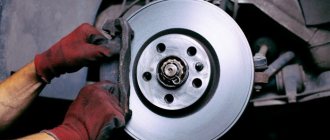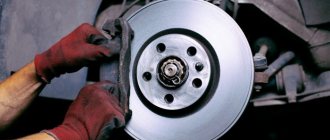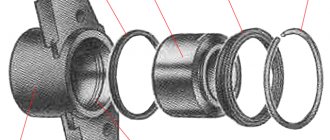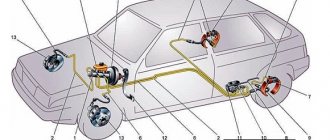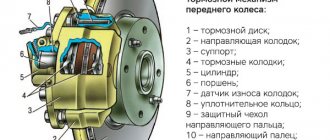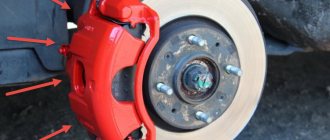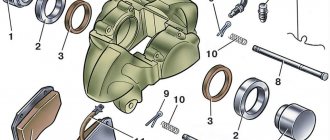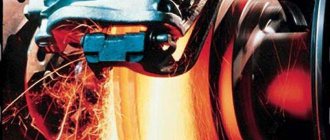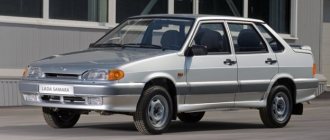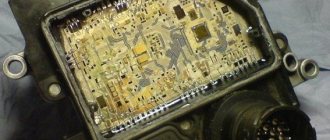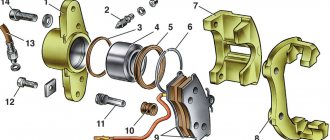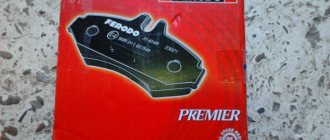Why the brake caliper jams: how to identify and fix the problem
Hi all! Any problems associated with the braking system of vehicles are potentially very dangerous. Therefore, every motorist should know why the brake caliper jams, what can provoke such a situation, how to diagnose and eliminate it. On your own or with the help of specialists, decide for yourself.
Our regular readers remember that we have previously talked about situations when the caliper knocks. Now let's consider a slightly different situation. Moreover, it is even more dangerous and unpredictable in terms of possible consequences if nothing is done after noticing the symptoms.
Let's start with the theory. The caliper on a car is part of the brake system. It is used in the design to press automobile brake pads when the corresponding pedal is pressed against the brake disc. As you understand, the node is extremely important.
But sometimes it can jam and creak because of this.
Features of work
First, let's try to imagine the ideal operation of a caliper as part of a car's braking system.
In fact, this is a mandatory component of any car, be it:
- VAZ 2110;
- VAZ 2109;
- Lada Kalina;
- Chevrolet Lanos;
- Lada Priora;
- VAZ 2114;
- Chevrolet Niva;
- Lada Kalina;
- VAZ 2112;
- Daewoo Nexia;
- Volkswagen Polo Sedan;
- Skoda Octavia;
- Mercedes E class, etc.
Regardless of whether it is installed on a Niva or a BMW, the caliper must be in constant working order.
This is the direct task of the car owner himself. Or persons responsible for maintaining the machine and maintaining it in proper technical condition.
Before determining why it does not press out and what to do to prevent the car caliper from jamming, you need to understand the principle of its operation.
In optimal condition, when the brake assembly is working properly, the operating diagram looks like this:
- the driver presses the brake pedal;
- pressure is built up inside the braking system;
- this pressure is transmitted to the piston group of the auto calipers;
- the calipers, being under high pressure, bring the brake pads to the disc;
- the braking disc is attached to the car wheel;
- friction force arises;
- wheel rotation slows down;
- the car stops;
- or reduces the speed to the required values.
As you can see, in theory there is nothing complicated. But in fact, the caliper is rightly called an extremely complex element.
For the brakes to work effectively, it is important to ensure that the pad is parallel to the disc.
Friction during active braking causes heat production. This heats up the pad, brake fluid and our caliper.
Therefore, it is extremely necessary that the car caliper be made on the basis of a material that does not change its properties and characteristics during the process of strong heating. Plus, there are increased requirements for strength.
Causes of jamming and creaking
Now directly about how to determine the presence of a problem.
The primary sign indicating a malfunction in the calipers of a car brake system is squeaking.
It is the creaking that indicates that the element is seriously worn out. In the near future, the unit must be replaced without fail, which the car literally and figuratively screams about. It is extremely difficult not to hear such a creak. But for some reason, thousands of motorists still stubbornly ignore it. As a result, they pay a rather high price. Sometimes even to the point of road accidents resulting from brake failure while driving. To prevent this, you need to understand the issue and understand the essence of what is happening.
The first step is to look at the possible causes. In fact, there are several potential problems to look for. Some of them arise due to the fault of the motorist, others are caused by the natural process of wear and tear.
In any case, the appearance of a squeak as a symptom is a harbinger that at the most inopportune moment the caliper may simply jam.
If you know the reasons, you can prevent them and troubleshoot them by contacting a car service center or solving the problem yourself.
The reasons are:
- The brake pads were initially installed incorrectly. As a result, they are not strictly parallel to the response drives. Because of this, creaking often appears;
- The brake discs are seriously worn out. The reasons are natural wear and tear and aggressive use of the car;
- There is no lubrication in the unit. Initially there was little of it, or it was used up;
- The lubricant was selected incorrectly. Many people skimp on lubricant intended for calipers, hence the consequences.
The most undesirable and dangerous situation is rightly considered when the piston does not return and the unit begins to jam during operation.
Imagine that you are driving a car, press the brake, and then accelerate again. But at the same time, the calipers do not release the front brakes. Additional resistance arises, the car tries to move, but cannot. The result is uncontrolled braking, extremely intense wear and serious overheating of the entire system.
What to do in such a situation
If you were able to diagnose creaking and signs of wedging in this unit, you need to perform a number of measures.
And here it is not necessary to contact a car service. You need:
- put the car on a jack;
- remove the wheel;
- unscrew the caliper;
- remove it;
- unscrew the problematic piston;
- remove the piston from the cylinder;
- visually inspect the element;
- check for chips, damage, corrosion;
- if there is rust, clean it;
- if severely damaged, replace;
- drain the working fluid from the element;
- remove the sealing ring;
- clean all surfaces;
- dry;
- fill in new hydraulics;
- assemble in reverse order.
When putting the assembly back together, pay special attention to not accidentally damage the old boot. If you notice cracks on it, then no restoration will help. Replacement only.
Prevention measures
I can say from personal experience that the detailed cleaning procedure is quite complicated. This will definitely take more than one hour.
To minimize the number of repetitions of such operations, be sure to lubricate the caliper twice a year for preventive purposes. It is optimal to use professional special lubricants designed specifically for this element. But regular WD40 is also an alternative. It will definitely protect against corrosion.
Plus, visually inspect the condition once a year. Make sure that the assembly is free of damage, dirt and signs of corrosion. Make sure that the boot does not rupture during operation. Otherwise, the caliper will not last long after this.
You need to monitor all brake systems, including periodic adjustment of the handbrake. After all, this is also an integral part of vehicle safety.
Source: https://pricep-vlg.ru/remont-svoimi-rukami/pochemu-klinit-tormoznoy-support/
VAZ 2115 brakes jam
- To the beginning of the forum
- Forum Rules
- Old design
- FAQ
- Search
- Users
In the summer I installed 14th ventilated brakes on my car.
I drove for the first time and noticed that the hubs were heating up after trips, I thought that everything new was still getting used to. After 2 weeks, I thought it was time to get used to everything. I took off the wheel, removed the pads (by the way, the new boots on the guide calipers had already cracked by that time), and discovered that it was the guides that were jamming, although they were lubricated and new. If the guide bolts are not tightened, the bracket moves easily; as soon as you tighten it, it immediately jams; you cannot move it by hand. The first thing I thought about was the guides themselves; I had another new set of guides on hand. I installed new ones and the jamming seemed to be less, but it still jammed when tightened. I selected a position for the guides that would not jam them, and assembled the calipers that way.
I immediately noticed that the hubs stopped heating up after driving.
Now I notice that the front brakes have started to jam again, now I’m wondering where to start.
In general, I understand that this is not a normal situation when the guides move freely in only one position.
Now I notice that the front brakes have started to jam again, now I’m wondering where to start.
It is the guides that are jamming, although they were lubricated and new. If the guide bolts are not tightened, the bracket moves easily; as soon as you tighten it, it immediately jams; you cannot move it by hand.
All this happened one on one (albeit on the 13th radius.). Using the “light tapping” method, I achieved alignment of the guides and their easy movement. 7 months - normal flight.
Please describe the procedure, how you tapped. It’s probably more convenient with the brake disc removed: tap it and try it on??
Analysis of the brakes revealed that the guides move easily, apparently they have been worn in, BUT when you press the brake and after releasing the pedal, the wheels do not release completely. The pistons in the cylinders move back, and the wheel jams.
It turned out: The surface of the piston that presses on the block is not perpendicular to the axis of movement of the piston, because of this, when you press the brake, the entire caliper warps and in the skewed state the guides become stuck. Today I'm thinking about changing the cylinders. Let's see if it helps or if the brackets are of the same quality as the cylinders. A friend who works with spare parts brought the spare parts. Apparently there is some kind of marriage.
Source
Front wheel brake cylinder sticks
18.07.2019
Issues discussed in the material:
- How do brakes work?
- What are the main causes of front brakes sticking?
- What other faults can cause the front brakes to jam?
What daily manipulations does every person who moves during the day by car do? He gets into his car, starts the engine, warms it up a little and starts driving. And here an unpleasant surprise can await him: the car does not move! If this has not happened before, then it is difficult for the driver to understand what is going on, especially if his driving experience is not yet very long. The reasons why the front brakes stick can be different. To learn how to distinguish and eliminate them, you must first understand the theoretical side of the issue.
How the brakes work
The serviceability and correct operation of the car's braking system determines whether you can drive it normally or not. The law prohibits driving a car with broken or jammed brakes, even if it is a minor problem. This is still unsafe for both you and other road users.
To understand possible malfunctions and understand why the front brakes jam, you need to have an idea of the principle of their operation. The braking system in modern cars consists of brake discs or drum pads, which mechanically, if necessary, slow down the speed of the car.
The system works like this: the brake pedal is pressed, the piston in the main brake cylinder moves, “adjusting” the brake fluid, which, in turn, passing through the lines, affects the brake cylinders of the wheels. They press pads equipped with a friction mixture against the discs or drums.
VAZ 2115 brakes jam
- To the beginning of the forum
- Forum Rules
- Old design
- FAQ
- Search
- Users
and what exactly can be in a university?
We perform assembly in reverse order.
When the engine is not running, the free play of the brake pedal should be 3-5 mm.
We adjust the free play by moving the brake light switch while the nut securing it is loosened. The brake light switch is installed so that its buffer rests against the pedal stop with a free travel of the brake pedal of 3-5 mm. In this position, tighten the brake light switch mounting nut.
Guys, wow. help is needed! The brakes recently hissed - I changed the vacuum seal, everything became ok. After replacing the VU, I drove about 100 km, and began to feel that the car was not pulling... After 5 km, it completely stopped, so that you couldn’t move it. Both front wheels are blocked. The pedal is dead, you can't press it. It stood for half an hour - it cooled down, it drove off, but not perfectly, but also with effort. after 5 km it stopped again.. the brake discs were red, hot.. I unscrewed the hose to the front wheels from the GTZ, bleed the brakes - it helped.. but at 10 km.. I looked at the pads, brake cylinders - everything is fine.. What kind of nonsense could this be? ? Could it be because of the vacuum seal? and in general the situation is strange... the car has diagonal brake circuits, but both front ones are blocked. Help whoever can.
The problem could be due to several reasons. First, make sure that the brake cylinders themselves are not sticking. Secondly, the reason may be in the vacuum seal. Judging by the message? this is the most likely reason.
How does the vacuum cleaner behave when you start the car? If the brake pedal does not go away after the factory (it sticks), then the vacuum seal needs to be changed. On the other hand, the vacuum sealer can only work partially. The pedal goes away, but while driving the brakes begin to jam (partial release of the brakes). As correctly pointed out here, the vacuum seal is also to blame for this.
Unfortunately, can you adjust it manually? this is problematic. The vacuum unit is adjusted on a special stand. Therefore, take a check, stock up on an expert opinion (a number of services provide this), and replace the vacuum seal with a new one. Sometimes you have to change up to five pieces. DO NOT REGULATE YOURSELF. Otherwise, you will not be able to replace it under warranty.
